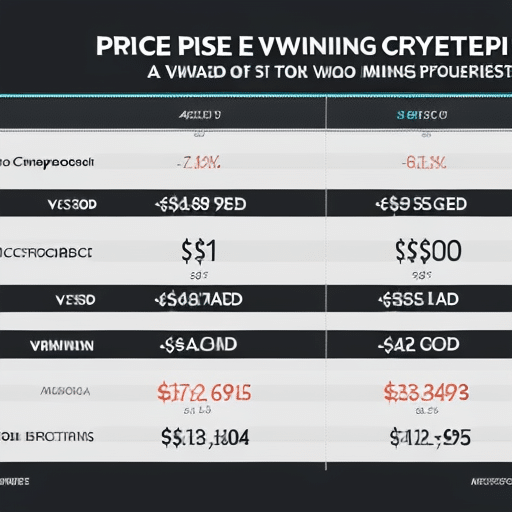Xrp Technical Progress
XRP is a digital asset built on the open source distributed ledger technology, RippleNet. It was created to facilitate fast and secure cross-border payments, and has been adopted by various financial institutions worldwide. This article will discuss the technical progress of XRP, its potential as a settlement asset, liquidity providers, challenges that face the network, regulatory considerations, and its impact on the cryptocurrency market. Furthermore, this article will explore potential opportunities for growth within XRP in order to assess its future prospects.
Technical Progress of XRP
XRP has made significant strides in terms of scalability, speed and security improvements, as well as development of advanced features. Scalability improvements have enabled the system to process more transactions per second. Enhancements in speed and security have improved transaction throughput while also protecting users from potential vulnerabilities. In addition, XRP has developed a number of advanced features such as smart contracts and atomic swaps which are allowing for greater flexibility and usability within the platform.
Improvements in scalability
Scalability of the Ripple protocol has been improved significantly, with a throughput up to 1500 transactions per second; yet, how can these advancements be leveraged further? The possibilities are far-reaching:
- Scalability solutions such as sharding could help achieve greater levels of decentralization.
- Transaction fees could be reduced without sacrificing security or network performance.
- Off-chain scalability solutions could provide faster and more secure transactions for users.
- Improved consensus algorithms could increase the overall efficiency of the network.
This provides an opportunity for creative thinking from developers to explore new ways to maximize the capabilities of XRP’s ledger technology and improve its scalability further. Enhancing speed and security are also key areas that need continued focus in order to make XRP an attractive payment alternative moving forward.
Enhancements in speed and security
Enhancing speed and security of the Ripple protocol is essential for making it an attractive payment alternative. To accomplish this, various technologies have been implemented that allow for the development of advanced features. Smart contracts are particularly important in improving execution speed and interoperability. By providing a secure way to execute automated transactions, smart contracts can be used to create agreements between different institutions, which has enabled faster payments with fewer errors. Additionally, using digital signatures helps ensure that only authorized parties can access certain data while preventing frauds from happening due to unauthorized users accessing information. Moreover, other measures such as two-factor authentication help provide better security against malicious attacks.
Alongside these existing developments, Ripple has also introduced new features that are designed to increase scalability and performance further. These include a distributed ledger system called XRP Ledger that can process up to 1,500 transactions per second and provides support for decentralized applications (dApps). In addition to this, various upgrades have been made over time such as improved consensus algorithms and deterministic validators which enable robust transaction verification processes while increasing the speed at which transactions are processed significantly. All of these advancements demonstrate Ripple’s commitment towards enhancing the security and performance of its protocol in order to meet the changing needs of customers across multiple industries.
Development of advanced features
Ripple has introduced a range of innovative features designed to revolutionize the way payments are made, enhancing security and speed while providing unprecedented levels of flexibility. This includes the development of smart contracts which allow users to design their own payment agreements or transactions without needing to write code. Smart contracts also provide greater transparency into financial transactions, allowing for improved trust between parties involved. Interoperability is another important feature that Ripple has developed, allowing customers from different networks or systems to transfer money quickly and securely without needing to convert currencies or establish complex processes. All these features have been incorporated into the XRP Ledger, making it one of the most advanced digital ledgers in the world today. Transitioning seamlessly into this new realm of technology will bring with it more efficient operations and a higher level of trust between all involved in financial transactions.
XRP Ledger
The XRP Ledger is a distributed ledger technology that facilitates secure, low-cost financial transactions. It is an open source platform designed to provide fast and reliable payments with very low transaction fees and minimal network congestion. The core features of the XRP Ledger include:
- A consensus process that ensures all participating nodes agree on the same state of the ledger;
- An efficient payment system based on trust lines;
- An efficient exchange system built on top of this trust system, which allows users to trade assets without counterparty risk.
The XRP Ledger also enables a wide range of applications such as smart contracts and decentralized applications (dApps). All these features help make it one of the most advanced blockchain technologies currently available. As a result, RippleNet can provide businesses with access to faster, more secure and cost-effective cross-border payments than ever before.
RippleNet
RippleNet is like a complex web of interconnected nodes, providing reliable and efficient cross-border payments to businesses around the world. At its core, RippleNet enables fast, secure and cost effective transactions across multiple currencies and asset classes by utilizing smart contracts and advanced blockchain technology. RippleNet’s network of banks, payment providers and digital asset exchanges provides users with access to a variety of currencies and assets for settlement purposes. Interoperability between RippleNet nodes allows customers to move funds quickly between different countries without having to worry about exchange rates or transfer fees. This makes it easier for companies in different parts of the world to trade with each other more effectively, thus improving global economic efficiency. By using RippleNet as their settlement layer, businesses are able to access faster payments from anywhere in the world at competitive costs. With its innovative features, RippleNet helps facilitate global payments on a larger scale than ever before. As such, it serves as an excellent bridge for companies looking to extend their reach globally while reducing costs associated with international transfers. With these capabilities in place, XRP becomes a powerful settlement asset that can help accelerate the process of international commerce even further.
XRP as a Settlement Asset
XRP serves as an effective settlement asset, enabling businesses to quickly and securely transfer funds across multiple countries with the potential to revolutionize global commerce. Institutional investors have largely been attracted due to its ability to facilitate cross border payments faster than traditional methods, while charging significantly lower fees. XRP has thus become a popular choice for large scale transactions as well as for small scale daily payments. The underlying blockchain technology that supports XRP also provides a secure platform for processing payments and storing value, making it suitable for use by individuals and businesses alike. With increased acceptance of RippleNet, XRP liquidity providers are becoming more prominent in the market, creating new opportunities for investors interested in capitalizing on the asset’s growth potential.
XRP Liquidity Providers
Market makers are important participants in the XRP ecosystem as they provide liquidity, allowing businesses to easily buy and sell XRP. By providing a steady stream of buyers or sellers, market makers offer benefits such as reduced spreads and higher trading volumes. These features allow businesses to quickly execute large orders at more efficient prices which can increase profitability and reduce costs.
Overview of the market makers
Analyzing the role of market makers in cryptocurrency trading can provide a better understanding of the dynamics at play. Market makers are entities that are incentivized to maintain liquidity within a given crypto network by providing buy and sell orders for assets. These orders create an order book, which is composed of prices and amounts that allow buyers and sellers to trade their desired asset. The incentives for market making come from network incentives as well as liquidity incentives. Network incentives refer to rewards such as token emission or transaction fees, while liquidity incentives include spreads between bid and ask prices that will generate profits over time. As a result, market makers have become essential components in facilitating transactions within the crypto market, providing investors with more opportunities to trade their desired asset quickly and efficiently. This leads to improved capital efficiency since it allows for faster trades with lower costs, creating an efficient environment where businesses can operate with minimal overhead costs.
Benefits for businesses
The market makers of XRP play a significant role in the growth of the cryptocurrency since it enables them to hedge their risks and increase liquidity. Furthermore, they are also able to benefit from its high speed transactions and low transaction cost. This has made XRP attractive to businesses as an efficient means for cross border payments. Additionally, businesses can utilize XRP’s digital identity feature that can be used to identify people or organizations involved in transactions, minimizing the potential for fraudulent activities. These features make XRP an attractive option for companies looking for a reliable way to send money across borders quickly and securely. As such, businesses are increasingly turning towards XRP as a viable solution when sending large amounts of money internationally. With this shift in focus, more companies are beginning to recognize the benefits associated with using XRP as part of their business operations.
XRP Use Cases
Examining the potential use cases of XRP, it is evident that this cryptocurrency has the ability to revolutionize existing financial systems. XRP can be used for a wide variety of applications in the decentralized finance and global payments industries. One of its most promising uses is as a payment rail, allowing transactions to occur at speed and with low cost no matter where in the world they are sent. This could potentially replace traditional bank transfers, credit card payments, and other forms of money transfer as these processes are usually expensive and slow. Another use case for XRP is enabling banks to open up new liquidity channels by allowing them to access capital from different nations without having to go through costly intermediaries when making cross-border payments. In addition, it could also be used for hedging against currency exchange rate fluctuations or even provide a stable medium of exchange in countries experiencing financial instability. By providing fast, secure, and low cost remittance services across borders, XRP could drastically improve global access to financial services and create more inclusive economic opportunities worldwide. With these advantages in mind, it is clear why XRP has become an attractive option for businesses looking to better manage their finances on a global scale.
Benefits of XRP
With its lightning-fast transaction speed and low cost of processing payments, XRP offers a variety of benefits for businesses and individuals alike. The major advantages of XRP include:
- Global Adoption – XRP is one of the most widely used digital assets in the world, making it an attractive choice for worldwide payments.
- Interoperability Solutions – XRP enables financial institutions to access new markets more quickly and easily than ever before.
- Cost Savings – Transactions on the Ripple network are much cheaper than traditional methods of payment processing.
These benefits make XRP an ideal choice for companies that require fast, efficient, and cost-effective global payments solutions. By leveraging the power of XRP’s technology, organizations can gain access to new markets faster while saving money on international transfers. This makes it an attractive option for organizations looking to expand their reach globally as they can benefit from increased efficiency and savings with minimal effort or risk. As such, its adoption continues to grow across industries which further solidifies its position as a powerful tool in facilitating global commerce.
XRP Adoption
Adoption of the digital asset XRP has been steadily increasing as organizations recognize its potential to facilitate global commerce. The token economics and related regulations provide an attractive platform for businesses and individuals alike to transfer funds in a secure, efficient manner. As more companies embrace the technology behind XRP, they are finding ways to leverage it for their own operations. For example, banks are using XRP-enabled systems to reduce costs associated with traditional money transfers while remittance companies use it to quickly move value across borders. Furthermore, financial services firms are exploring ways to use XRP’s distributed ledger technology (DLT) for trading securities and other assets on a global scale. As these advancements continue, there is no doubt that the adoption of XRP will continue to grow.
The increased adoption of XRP also presents some challenges that must be addressed in order for the asset to reach its full potential. Regulations governing digital tokens vary from country to country, making it difficult for entities operating on a global level to comply with all applicable laws. Additionally, the relatively young age of the asset means that many users lack experience working with it or any other cryptocurrency and may require additional education before they can effectively utilize it within their operations. Nonetheless, these issues can be overcome through targeted efforts such as developing unified regulations or creating educational resources tailored specifically towards users unfamiliar with DLT-based technologies like XRP. With proper implementation, these measures could help drive further growth in adoption levels moving forward into the future
Challenges Facing XRP
The increasing adoption of XRP is not without its challenges, which are illuminated like a beacon in the night sky. Regulatory compliance and liquidity concerns are two primary challenges facing the cryptocurrency, both of which present unique difficulties to those seeking to use XRP for their transactions. |
| Regulatory Compliance | Liquidity Concerns |
| Regulation surrounding cryptocurrencies changes frequently and can be complex, with different regulations applied by various countries, states, and even cities. This makes it difficult for users to stay up-to-date on the current regulatory requirements for using XRP. | The sheer number of users participating in the Ripple network means that there is a lot of demand for liquidity when it comes to exchanging XRP tokens. However, due to the limited supply of tokens available on exchanges, this has created an artificial shortage which drives up prices and can make it difficult for users to acquire them at a reasonable cost. |
Due to these issues, any user looking to adopt or use XRP should be aware of both regulatory compliance requirements as well as potential liquidity concerns associated with using this cryptocurrency. As such, navigating these complexities requires careful consideration before diving into any transaction involving XRP tokens. Without proper preparation and research into these topics prior investing in or using XRP tokens may lead have serious implications down the line. Therefore, understanding these considerations is critical for anyone attempting to leverage the benefits provided by this digital asset class.
Regulatory Considerations
Navigating the complexities of regulatory compliance when using XRP presents a unique challenge; it is essential to understand these considerations before investing or transacting in this digital asset class, lest potential consequences befall an unwary user. As such, there are three primary components to consider when assessing the regulatory environment surrounding XRP: open source adoption, institutional investor acceptance, and government policies.
Open source adoption is important for a cryptocurrency like XRP since it helps inform its market value and provides greater insight into its development trajectory. Institutional investors must also take into account their own internal policies around cryptocurrencies when evaluating whether to add them to their portfolios. Finally, government policies play a significant role in shaping the overall landscape for digital assets such as XRP by influencing how taxes are calculated on transactions involving them and what types of legal requirements they must adhere to. By understanding all of these considerations, one can make more informed decisions about how best to invest or transact with XRP. With this knowledge in hand, we can now examine the impact of XRP on the cryptocurrency market.
Impact of XRP on the Cryptocurrency Market
As one of the largest digital assets, XRP has made a significant impact on the cryptocurrency market. XRP is used by many market makers and other financial institutions as an efficient way to transfer funds across borders and quickly settle transactions. The use cases for XRP have been steadily increasing since its launch in 2013, resulting in a growing presence in both traditional and crypto-based markets.
XRP has seen an increase in adoption among major exchanges, which has resulted in increased liquidity for traders. This improved liquidity has enabled greater price discovery and more efficient trading strategies, making it easier to capitalize on short-term opportunities with lower risk. As more investors begin to realize the potential of XRP for creating wealth, its influence in the cryptocurrency markets will continue to grow.
Future of XRP
Given its widespread adoption, it is clear that XRP has the potential to become a major player in the cryptocurrency market. But what does the future hold for this revolutionary digital asset? In order to gain an understanding of the future of XRP, one must first consider both its current use cases and possible applications.
XRP is currently being used as a bridge currency between different fiat currencies and altcoins. This allows for fast and efficient digital payments without having to go through traditional banking infrastructure. As such, XRP could potentially revolutionize international finance by providing a secure and cost-effective alternative to existing payment systems. Furthermore, XRP’s low transaction fees make it attractive for individuals who are looking to send or receive money quickly and cheaply over long distances. Additionally, recent developments have shown that XRP can also be used as collateral for other cryptocurrencies, further increasing its utility in the digital asset market.
| Use Cases | Potential Applications | Benefits |
|---|---|---|
| Bridge currency | International finance | Secure & cost-effective |
| Low transaction fees | Collateral for other cryptocurrencies | Quick & cheap transactions |
Frequently Asked Questions
What will be the long-term effects of XRP on the global economy?
The scalability of nodes and the digital assets associated with XRP could have a significant impact on the global economy. Its potential to facilitate faster, more secure transactions could revolutionize payment systems, while its ability to increase liquidity can lead to increased investment opportunities.
What are the potential risks associated with investing in XRP?
Investors should consider cost benefit analysis, legal implications and potential risks when investing in XRP. Financial losses, regulatory changes, and technological malfunctions are all possible risks associated with the digital asset. A thorough assessment of these factors is critical before any investment decision is made.
What measures are being taken to ensure the security of XRP?
To ensure security of XRP, developing tools to address scalability challenges are being used. These tools include improvements to the consensus protocol and increased emphasis on security testing and code optimization. Additionally, quality assurance measures are implemented to identify and mitigate potential risks.
How will XRP be affected by changes in the cryptocurrency market?
The cryptocurrency market is constantly changing and it is expected that XRP will be affected by these changes. Exchange platforms may experience an impact on liquidity and scalability challenges could present themselves for the technology. As such, it is important to keep abreast of developments in the market to ensure XRP remains competitive.
What are the potential uses of XRP outside of financial services?
XRP has the potential to be used for various applications beyond financial services, such as data streaming and content delivery. It provides a secure platform for these activities due to its distributed ledger technology, which is fast, cost-effective, and reliable.





